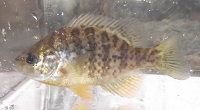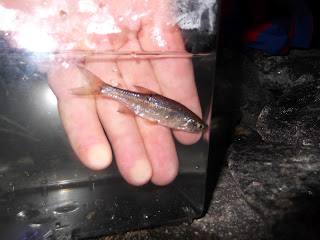….and boy do I have a long way to go.
Since my last entry, I have to catch up dating back through March 3. This duration has included 13-new species of new fish on the year, four New England states, and one trip offshore.
So here goes; starting with last weekend in Maine.
Third trip up there this year. This time I visited at the invitation of Calvin, brother of Eva and schoolboy friend from my senior year at Bridgton Academy (1978.) The invitation was to accompany him as he went smelting.
When it comes to fishing, few match Calvin. He has made many, many tens of thousands of dollars off of catching them. “But you have to do your homework. I’ve been all over this state, sometimes putting hundreds of miles into it nightly,” he told me.
Last Friday, with a full moon heralding a downright cold night, we visited a half-dozen streams in Waterford and Bridgton in search of the smelts “running black.”
We never did find the smelts this thick, however in our party of four, about a quart was caught. With a two-quart limit per man (I didn’t count- purely an observer), they were disappointed, but I certainly wasn’t because rainbow smelts (#23) were a lifer for me.
Rainbow smelt (#23)
Calvin
* * *
Earlier in the day, back in Rhode Island before I drove to Maine, I bicycled out to Third Beach for a meeting with Kim Botelho and Chris Powell to discuss design layout for this summer’s version of the aquarium. On the bike ride back to Newport, along the dike of Easton’s Pond, I stopped briefly to look at the banded killifish seen back in January.
This time, a larger, black-striped fish was in the midst of a school. It darted away, however when I followed the fish along the dike, it soon meet up with more. I snapped this cloudy photo of them through about two feet ofwater
Barely visable
Moments later I found this fish trying to hide in the mud and took some clearer photos.
Later, when I got a chance to look at the photographs, I could tell they were indeed yellow perch .
* * *
Two weekends before, March 23-26, I also went to Maine, this time further north to Eva’s house in Clinton, Kennebec County, north of Waterville. Her house is directly on the Sebasticook River, a 43-mile-long river that feeds into the Kennebec River.
Sebasticook from Eva's house, looking north.
Throughout the weekend, I investigated various waterways around her house including the river itself. I saw three species; longnosed dace (#20), ninespined stickleback (#21) in two locations, and pumpkinseed. The dace are lifers for me.
Nine-spined stickleback Longnose dace
* * *
The weekend of March 17-18 was huge. It’s hard to believe it was almost a month ago.
On Sunday, I got offshore on board the party fishing boat “Seven B’s” out of Galilee as an observer during a cod fishing trip. I have worked off and on this boat for about 15-years for both Shark Safaris and for narration during Tall Ships festivals that come to Newport every few summers. The “Seven B’s” is a lovely 90-foot Florida-built boat that can handle up to 150-passengers for sightseeing or about 40-fishermen or shark watchers.
"Seven B's V" out of Galilee, Rhode Island
Although the fishermen didn’t catch as many fish as they would’ve liked (they rarely do), for me it was a terrific trip.
Here are photos of the six species that were caught.
Long-horned sculpin (#14)
Cunner (#15
Sea raven (#16)
Atlantic cod (#17)
Spiny dogfish (#18)
Barndoor skate (#19)
The skate is a lifer for me.
The birds were great too. We were at times surrounded by pelagic fancies like razorbills, thin-billed murres, and fulmars. These were in addition to the more familiar loons, gannets, and all three scoter species.
At one point, I could only see a pair of other fishing boats on the horizon. I recognized them as the “Lady Frances,” also out of Galilee, and the “Viking Starship” out of Montauk. I couldn’t help but smile because I have, in the now-seemingly distant past, worked on all three boats.
* * *
The day before, prompted by a tip by Steve Erickson at work, after the St. Patrick’s Day parade in downtown Newport, I drove to the La Sellette religious shrine in Attleboro, Massachusetts. Here were goldfish(#12) and pumpkinseeds (#13) in the pools. I have no reservations about counting the goldfish, because Steve and I had read they have been present in this pond since the Eighteenth Century. With a presence in those waters for over 100-years, to me, that qualifies as a sustainable population.
The dark blob is a pumpkinseed.
* * *
On Saturday, March 10th, I explored the Beaver River in western Rhode Island and turned up yellow perch (#12) in Richmond. That is a new fish for me.
Yellow perch fry
Beaver River habitat shot * * *
Finally, the last trip I have to catch up on is that of March 3 to the Connecticut River.
I had been recruited at the last minute to be the naturalist for Connecticut Audubon Society’s Ecotravel Winter Eagle Cruises on board the “Riverquest” out of Haddam.
"Riverquest" out of Haddam, Connecticut
After helping for many years in leading a number of various nature trips in southern New England, ten years ago, Connecticut Audubon Ecotravel offered me a free trip on a tour to Tuscany, Italy. Then eight years ago, I was again their guest on another free trip to the Pantanal in Brazil. So when they call, I feel beholdent to them. For a number of years, Ecotravel has teamed up with the “Riverquest” and conducted eagle trips throughout the winter up and down the lower Connecticut River.
Despite the season winding down, we did see eight bald eagles on the two trips I sailed with them.
My blurry photo, however the head is turned the wrong way.
After the trips, I drive east through inland Connecticut Central City to visit the Quinebaug Valley state trout hatchery. Although I got there just as it was getting dark, in the outflow stream behind the hatchery, I did encounter bluegill and golden shiner (#11.)
BluegillGolden shiner
* * *
Not a bad month’s work!


























Your "yellow perch fry" is actually a trout fry - likely a brown trout. Note the single, soft dorsal fin (yellow perch have two dorsal fins - one spiny one soft), as well as the adipose (cartilage) "fin" near the tail. Only three groups of fish have adipose fins - salmonids, catfishes, and tetras. Otherwise, everything looks right. Great photos!
ReplyDelete